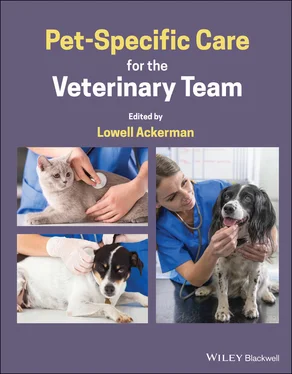We did a survey with the local ACCT club and found that of 1000 dogs, 53 had von Willebrand disease. The ACCT club seemed happy that the prevalence of the disorder in the breed was of the order of only about 5%. Using the figures from the survey, the actual genotype frequency for homozygous recessive ( q 2) is 0.053 and the gene frequency ( q ) is the square root of 0.053, or 0.23. We know the sum of p and q equals 1, and q equals 0.23, so p must equal 0.77, and p 2, the proportion with the homozygous dominant genotype, equals 0.59. On the basis of these numbers, 2 pq, or 0.35 (35%), would be predicted to be the likely proportion of heterozygous carriers in the population.
What does this exercise in algebra tell us? Well, it tells us that although only 5.3% of ACCTs actually have von Willebrand disease, an incredible 35% of the ACCT population are carriers of the trait, which is not detectable by conventional means. The breed club has a potentially serious problem and would be best advised to invest money in a genetic test to detect heterozygotes. In the interim, however, the goal is to identify heterozygotes by other means so that animals that are homozygous normal can be discerned. We'll have to do the best we can with von Willebrand disease testing and progeny testing to differentiate normal homozygotes from normal‐appearing heterozygotes until that DNA test becomes available.
Identifying dogs that are homozygous recessive is not a problem. They are the ones with von Willebrand disease. We also know that both normal‐appearing parents of these affected animals are heterozygotes, carriers of the trait. Nevertheless, most of the other heterozygotes, which we would like to avoid breeding together, are clinically indistinguishable from the homozygous normal animals that we would like to use in our breeding program. For example, because we know that the parents of affected animals are carriers, it follows that at least one of each of their parents (grandparents of the affected animal) must also be a carrier. Inferring genotype from a family tree is known as pedigree analysis .
3.4.10 Preserving Genetic Diversity
Although establishing harsh criteria to rid breeds of genetic disorders by completely eliminating affected animals and carriers may seem reasonable, it is neither practical nor desirable. Because each animal carries nearly 20 000 different genes, ridding lines of all deleterious alleles is not possible. If carriers can be determined, however, breeding phenotypically normal dogs is a real possibility by never breeding two carriers together. If we are aware of heterozygotes, we can safely breed carriers with known normal individuals, and we will never see cases of the disorders we are trying to avoid. Is that not what genetic counseling is all about?
Trying to overcome polygenic traits takes longer and is more troublesome. Obviously, the higher the heritability of a trait and the more ruthless we are in selecting superior individuals for breeding, the more successful our selection process will be. This response to selection ( R ) can also be described as an algebraic function, R = h 2 S , where R is the response to our breeding strategy, h 2is the heritability of the condition, and S is the selection differential, the phenotypic superiority of the parents we selected versus that of the general population from which they came. The result is that the mean improves; it is not that the pups will be superior to their parents.
Hip dysplasia provides a good example of how selection pressure improves the standard, albeit slowly. Let's say we create a scoring system for hips in which 0 represents severe dysplasia and 100 represents perfect hips. In our ACCT, the mean hip score for the population is 55 and the heritability of the trait is believed to be 0.25. To try to improve hip joint morphology in the breed, we mate a stud with a hip score of 88 with a bitch with a score of 92. The average score of the parents is 90, which is 35 points higher than the mean for the breed. Should that produce terriers with great hips? The response to selection ( R ) is 0.25 × 35, or 8.75. Thus, in the litter produced, the mean hip score for the pups is predicted to be 63.75 (55 + 8.75). We have managed to shift the whole bell‐shaped curve of hip scores to the right, but not by the magnitude you may have expected. Now you see why creating real improvement with polygenic traits takes so long, even when using superior breeding animals.
In scrutinizing genetic reports in the literature, one must note that study bias is rampant in clinical research, even studies published in peer‐reviewed journals. Nonselection is defined as failure to include a subject or subjects from the population of interest in the experiment or study group; nonresponse is the failure to include a subject or subjects from the study population in the results and analyses of the study. Thus, for a disorder as common as hip dysplasia, prevalence data by breed are often contentious. Because submission of radiographs to most registries is voluntary, owners with dogs that are most likely to have hip dysplasia may see no reason to pay to have the radiographs submitted to the registry, which leads to substantial nonresponse bias and underestimation of the actual prevalence of hip dysplasia in these breeds.
This argument is not far‐fetched. Owners with dogs that have clinical evidence of hip dysplasia are not likely to ask to have radiographs taken because they know their animal will not be certified. Other owners, who have radiographs done thinking their animal is clear and learn that it has hip dysplasia, may elect not to have those reports sent to the registry, so as not to be stigmatized by the results.
Nonselection bias also plagues hip dysplasia statistics. Even if the registry decides to petition a national breed club, such as the ACCT Club, and asks all registrants to participate in a cost‐free hip evaluation plan to gather breed statistics on hip morphology, the potential for bias still exists. If the breed club has a strong policy of encouraging the breeding of only disease‐free dogs, might there not be dog owners who do not agree with those policies and therefore choose to not belong to the club? Or might there not be a sizeable population of owners of the breed who do not belong to the breed club because they are pet owners, not breeders? In any case, results cannot be extrapolated to the entire breed, just the frame selected for study.
Much of the research on which breed statistics for genetic disorders have been based is subject to nonresponse and nonselection bias. When bias is not addressed, readers are left to make their own assumptions on the basis of the results reported.
A better approach is for veterinarians to take a proactive stance and to consider preventive care on a pet‐specific basis whenever possible. In fact, understanding predispositions and risk profiles for individual pets allows veterinarians to create a lifetime care plan for most of their clients, based on the specific risks of each individual patient (see 1.2Providing a Lifetime of Care), even if risk cannot be completely assessed.
 EXAMPLES
EXAMPLES
A cocker spaniel breeder takes your advice and performs DNA testing for phosphofructokinase deficiency on a prospective breeding pair. The potential sire is clear, but the bitch is determined to be a carrier. What are the odds that this mating will result in affected pups?
Читать дальше

 EXAMPLES
EXAMPLES










